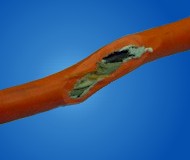
|
 |
Hospital eTool - HealthCare Wide Hazards Module
Electrical Hazards
Potential Hazard
Employee exposure to electrical hazards including electric shock, electrocutions fires, and explosions. Damaged electrical cords can
lead to possible shocks or electrocutions. A flexible electrical cord may be damaged by door or window edges, by staples and fastenings,
by equipment rolling over it, or simply by aging.
|

|
Possible electrocution or electric shock or contact with electrical hazards from:
- Faulty electrical equipment/machinery or wiring.
- Damaged receptacles and connectors.
- Unsafe work practices.
Possible Solutions
Comply with OSHA Standard 1910 Subpart S-Electrical-General. The standard is comprehensive and includes the following sections:
- Electrical equipment shall be free from recognized hazards [1910.303(b)(1)].
- Listed or labeled equipment shall be used or installed in accordance with any instructions included in the listing or labeling [1910.303(b)(2)].
- Sufficient access and working space shall be provided and maintained around all electric equipment to permit ready and safe operation and maintenance of such equipment [1910.303(g)(1)].
- Ensure that all electrical service near sources of water is properly grounded [1910.304(f)(5)(v)].
- Tag out and remove from service all damaged receptacles and portable electrical equipment [1910.334(a)(2)(ii)].
- Repair all damaged receptacles and portable electrical equipment before placing them back into service [1910.334(a)(2)(ii)].
- Ensure that employees are trained not to plug or unplug energized equipment when their hands are wet [1910.334(a)(5)(i)].
- Use safeguards for personnel protection and electrical protective equipment [1910.335].
- Select and use appropriate
work practices [1910.333].
- Follow requirements for Hazardous Classified Locations [1910.307].
Employers should use ground-fault circuit interrupters (GFCIs) on all 120-volt, single-phase, and 15- and 20-ampere receptacles.
|
- Wear and tear on electrical equipment or tools can result in insulation breaks, short-circuits and exposed wires. If there is no ground-fault protection, these can cause a ground-fault that sends current through the worker's body, resulting in electrical burns, explosions, fire, or death.
- The ground-fault circuit interrupter, or GFCI, is a fast-acting circuit breaker designed to shut off electric power in the event of a ground-fault and prevent injury to the worker.
|

Receptacle Type (GFCI) |
Additional Information:
|
|

